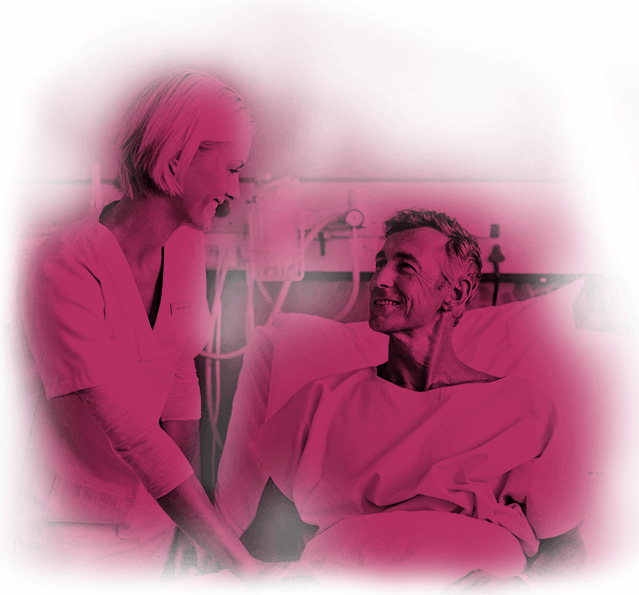Chronic Venous Insufficiency (Varicose Veins)
**At our VIRNA clinic we are able to see patients only with open venous ulceration/wounds. All other varicose vein referrals are to be directed to MIC.
Do you have varicose veins? If so, talk to your Doctor about referring you for a venous mapping of your legs. Depending on the results, there are a variety of treatment options available to you.
Most people refer to it as varicose veins. Unlike arteries, veins are thin-walled, low pressure conduits whose function is to return blood from the periphery to the heart. Muscular contractions in the lower extremities propel blood forward and a series of valves prevent retrograde (backwards) flow or “reflux”. Lower extremity chronic venous insufficiency is caused by high venous pressure.
Most patients develop venous hypertension from high venous pressure caused by reflux from primary valve failure. Venous obstruction (blood clots) and congenital abnormalities also can result in valve failure, but are much less common causes.
The 4 main causes are heredity, gender, pregnancy and age.
Heredity: this is one of the most important factors. If your parents and grandparents had the problem, you are at increased risk.
Gender: women have a higher incidence of varicose vein disease due in part to female hormones and their effect on the vein walls.
Pregnancy: blood volume increases during pregnancy and hormonal effects contribute to vein enlargement.
Age: the tissues of our vein walls lose elasticity as we age, causing the valve system to fail.
The following additional factors, while not directly causing varicose veins, may speed up the development of this disease and make the veins worse:
Prolonged standing: occupations that involve standing for a long period of time cause increased volume and pressure of blood in the lower limbs due to the effects of gravity.
Obesity: increases in weight often increase abdominal pressure which may worsen vein problems.
Hormone levels: treatments like birth control pills and post-menopausal hormone replacement may cause the same hormonal effect as pregnancy.
Physical trauma: injury to the lower limbs can damage underlying blood vessels and add to the problem.
There are many forms and grades of venous disease. For this reason, it can present in many different ways. Symptoms produced may vary dramatically but are often dependant on the site of the venous disease and the severity.
The venous system in the legs can be divided into three almost separate compartments:
- Surface veins
- Truncal or superficial veins
- Deep veins
Surface veins
- The surface veins start at the fine capillary level within the skin. This component of the venous system is mainly responsible for the visible blood vessel on the surface of skin. These small vessels ultimately reach and rain into the superficial veins.
- Symptoms caused by surface veins disease are mainly cosmetic. However, patients with extensive disease often describe a burning sensation or excessive heat over the affected regions. Abnormal vessels usually first develop over the upper side of the things and behind the knees.
- Symptoms caused by surface veins disease are mainly cosmetic. However, patients with extensive disease often describe a burning sensation or excessive heat over the affected regions. Abnormal vessels usually first develop over the upper side of the things and behind the knees.
- Generally these are treated with sclerotherapy.
Truncal or superficial veins
These vessels convey blood from the surface to the deep system. They account for approximately 15% of the blood returned to the heart from the legs. They include some common, “named” veins such as the greater saphenous and small saphenous vein.
Common symptoms associated with superficial veins:
- Reflux in these veins often result in varicose veins.
- Reflux can also result in leg swelling, skin pigmentation, skin scarring and in rare cases skin ulceration.
- Symptoms that develop include leg ache, heaviness, pain, burning sensation and diffuse dull throbbing pain.
Perforator veins
These vessels are the “connectors” from superficial system to deep system. They are short and straight.
Common symptoms associated with perforator veins:
Perforator veins are usually an issue only with superficial vein reflux as they can result in a localized area of worse symptoms such as ulcers or significant skin changes.
Deep veins
The deep venous system, as the name suggests, lies deep in between the muscle layers. This component of the venous system is responsible for returning large volumes of blood to the heart.
Common symptoms associated with deep veins:
- Disruption of this system results in severe symptoms such as; leg swelling, large varicose vein, skin scarring and ulceration.
- Generally symptoms are worse when compared to isolated superficial vein disease. Unfortunately, treatment options are quite limited.
Spider veins
- Also known as telangiectasis
- Very common, especially in women
- Increase in frequency with age
- May indicate more extensive venous disease
Reticular veins
- Enlarged, greenish blue appearing veins
- Frequently associated with clusters of telangiectasis
- May be symptomatic, especially in dependent areas of leg
Varicose veins
- Most common finding in patients
- Common skin changes suggestive of chronic venous insufficiency
Edema
- Pigmentation changes
- Ulcers
- Inflammation (phlebitis)
- Bleeding
The underlying conditions described above usually make “curing” varicose veins impossible, however certain measures may help relieve discomfort from existing varicose veins and prevent others from arising:
- Exercise regularly to improve leg strength and circulation (walking is ideal)
- Avoid standing for long periods of time
- Avoid sitting for long periods of time by taking short walks every 60 minutes
- Control weight to avoid placing increased pressure on leg circulation
There are a number of potential treatments:
Compression stockings
- Provides a gradient of pressure, highest at the ankle, decreasing as it moves up the leg
- Reduces reflux of blood
- Improves venous outflow
Sclerotherapy
Sclerotherapy involves the injection of a sclerosant into the diseased veins. The sclerosants most commonly used are Sodium Tetradecyl Sulphate. When sclerosant is injected into the diseased vessel, it causes the wall to become damaged that it initially shrinks, becomes inflamed and later “glued” to itself. The whole process can take anywhere from 3 to 4 months.
It has been used for spider veins since the 1930s and long before that for larger veins. Over the past 10 years the technique has been much improved with the use of ultrasound and sclerosant foam.
No. Due to limits in the volumes and concentration of sclerosant that can safely be used in any single treatment session, only one leg is treated at a time. The same leg may be retreated but not before a 6 week interval.
Depending on the size and location of the diseased vein, a selected concentration and volume of sclerosant is required. For this reason visible veins are treated using “micro” sclerotherapy because the diseased veins can be directly visualized. Diseased larger vessels require ultrasound.
No. Sclerotherapy is generally very well tolerated. Patients with a fear or phobia to needles have been treated with minimal fuss.
Generally there are anywhere from 1-4 injections. The needle used is finer than that used to take a routine blood test. Often there is no further sensation after injection.
Trapped blood occurs in approximately 1 in 3 patients who receive any form of sclerotherapy. As mentioned earlier, sclerotherapy causes shrinkage and closure of diseased veins. Often there are sections of incompletely treated veins between segments of completely treated veins. This trapped blood causes noticeable bruising and small segments of lumpy, tender veins but does not usually occur until 2 to 4weeks after the treatment session. To prevent pigmentation, it is important to release all occurrences of trapped blood. This is done with a needle prick and requires no other special care or attention.
Patients who are either immobile or unable to wear grade 2 compressive stockings are not suitable for sclerotherapy. Also patients with a strong history of deep venous thrombosis (DVT) or blood clotting disorder must be treated with extreme caution. The risk of DVT reported in literature has been in the range of 1 in 200 to 1 in 500.
Generally, veins treated adequately by sclerotherapy do not recur.
It is more important, however, to understand that the underlying weakness in the vein walls is not corrected by sclerotherapy and therefore new vessels will be expected to appear with time.
An annual “check-up” is recommended to detect the development of new veins earlier which can then be treated more readily. Future sclerotherapy treatments should be expected in almost all cases.
The ultrasound guided sclerotherapy procedure takes approximately 30 minutes to 1 hour.
Venous reflux in the greater saphenous or other superficial veins actually interferes with the normal venous return of blood. Closing or removing these areas improves venous circulation as blood is diverted to normal veins with functional valves. The resulting improvement in venous circulation significantly relieves symptoms and improves appearance. Blood will flow through the deeper leg veins. Keep in mind that the varicose vein was already working poorly.
In addition, dilated and malfunctioning varicose veins can be used for bypass surgery.




